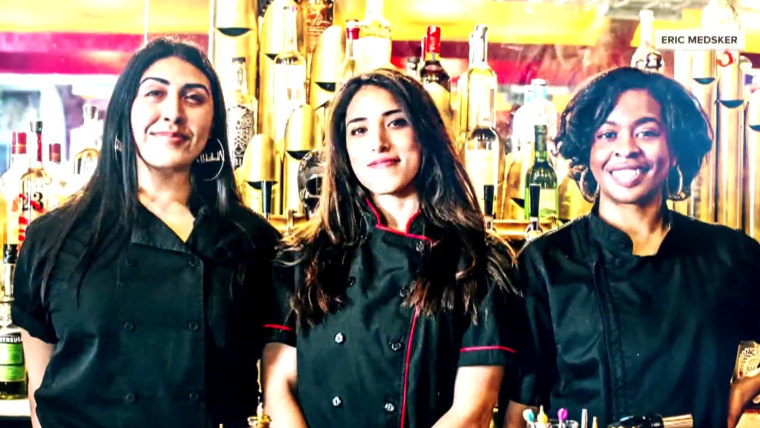With many of us still working from home over the past year, we looked to TikTok to spice up our food lives, trying everything from baked feta pasta to four-quadrant tortilla wraps. As the world opens back up, we’ll no longer be as reliant on what we can whip up in our home kitchens. What will this mean for healthy food trends in the coming year? Let’s read the tea leaves.
1. Sober curiosity goes all in
This trend has been growing for a few years and has seen a resurgence thanks to the super boozy pandemic, which drove alcohol intake to increase to worrisome levels. To help raise awareness around drinking too much, we’ve witnessed the rise of Sober October and Dry January. What’s different about the newest non-alcoholic or zero-proof offerings is that they’re well-crafted and feel just as indulgent as the real stuff — just without the hangover.
Elva Ramirez, author of “Zero Proof: 90 Non-Alcoholic Recipes for Mindful Drinking”, suggests that the new wave of sober curiosity stems from health-conscious consumers who like to have lots of options. “A lot of zero proof’s popularity comes from moderate drinkers, who want to have healthy options, but may still drink alcohol…consumers love the ritual of a well-made drink but are aware of how much liquor they are having each week,” says Ramirez.
Folks who want to enjoy a warming beverage on a cold winter’s night might turn to a snifter of Nightcap from Three Spirit, a “calming, woody” blend of maple syrup, hops, turmeric and valerian root. Or maybe you’d like to put a booze-free spin on one of your favorite holiday recipes, like bourbon cake or rum balls. Now you can with zero proof versions of vodka, rum, gin, and even tequila from CleanCo, a chef-driven brand from England. With no definite end in sight to the pandemic, all uplifting options are welcome.
2. Bottoms up on functional drinks
The pandemic has heightened our interest in wellness overall and beverages are a quick and easy way to infuse healthy ingredients into your day. That’s why so many of us are popping open bottles and cans of functional beverages that promise benefits ranging from gut health to better sleep to a happier outlook. Sales of functional foods and beverages grew 9.4% last year and are expected to climb higher in 2022 with people back at work and school.
While sales of traditional soda have slumped, prebiotic sodas from brands like Poppi, Gist and Olipop are bubbling up. These sparkling tonics come in nostalgic flavors including root beer, cola and grape and offer up something many of us are missing out on — fiber. Other functional beverages, like fast-growing Sunwink, use adaptogens and herbs in their sparkling tonics to offer benefits such as immune support and stress relief.
3. Reducetarianism
Plant-based options have exploded in recent years, which we’ve reported on before. What’s new is that so many Americans want to buy and use those products, even though they’re not going vegan. And the alternative meats are getting better, healthier and more like the protein they are aiming to replace. We recently tried the jackfruit-based nuggets from Jack and Annie’s, which have a much more chicken-like consistency than the soy or wheat gluten options we’ve had in the past. In the coming year you’ll also see pea protein nuggets from Nowadays.
The International Food Information Council (IFIC) recently found that a whopping two-thirds of Americans now report eating plant-based meat alternatives. While flexitarianism — ea
ting mostly plants with the occasional inclusion of meat, eggs and dairy — has been popular in recent years, reducetarianism differs in that it focuses on the gradual reduction of consumption of animal products. And food brands will be delivering plenty of plant-based products to fill in those spaces. Look for new options in plant-based cheese, elevated hummus, boosted beans and more.
The use of the original fruit vinegar, apple cider vinegar (ACV), as a health tonic has seen an explosion in growth in recent years. Touted for helping to aid weight loss and stabilize blood sugar, ACV has shown up in beverages, as well as gummy supplements and capsules. Now that consumers are familiar with the concept of using vinegar as an ingredient, we’re seeing more fruity options on the market.
Since one of the downsides of drinking straight ACV is that is the acid it contains can erode the enamel on your teeth, consumers have figured out other ways to incorporate vinegar into their diets, like adding them to salad dressings, smoothies, cocktails and nonalcoholic drinks. They add a bright, interesting note to whatever you add them to, and come in bottles gorgeous enough to display on your kitchen counter. Some we like are the citrus-forward Parasol vinegar from Brightland and Acid League’s Mango Jalapeno living vinegar.
If 2020 forced us to become home cooks, 2021 has made us more creative with our newfound culinary skills. And the next cuisine we’ll be tackling is South American. The Spice House has seen a 50% uptick in sales this year of their aji amarillo ground spice. Aji amarillo chiles add a medium heat, warmth and fruitiness to Peruvian foods like ceviche and huancaina sauce, which is typically served over potatoes and hard boiled eggs. Less skilled chefs can sprinkle it over scrambled eggs for an elevated brunch. You’ll find these orange peppers, which add a sunny yellow color to foods, in dried form, as well as canned, ground or as a paste.
Just like TikTok introduced Americans to birria tacos, social media is giving the same treatment to South American favorites like empanadas. Expect to see these hand-held, meat- and veggie-filled pastries at more restaurants and even meal kit delivery services, like Hello Fresh.
With the climate change movement finally gathering momentum, consumers are looking for actionable steps they can take that fight climate change while eating their afternoon snack. Food waste in this country accounts for the equivalent of nearly 33 million cars’ worth of greenhouse gas emissions. New brands, as well as established ones, are putting the fight against food waste front and center in the coming year.
Two Good (a product from Danone), is adding a new line called Good Save that uses fruit that would have otherwise been discarded. The packaging will feature a seal that lets consumers know that the produce inside the cup would have been wasted had it not ended up in the yogurt. Upcycled sweet potatoes are the key ingredient of Spudsy, a line of crunchy snacks, which saves about 15,000 ugly sweet potatoes with each truckload of their sweet potato puffs and fries.
Rind Snacks, which sells dried fruit with the nutrient-rich skin and peel on, saved over 120,000 pounds of edible fruit peels from going to landfills last year and plans to divert 1 million pounds next year. Of the nearly 40 million tons of food that are wasted each year, fruits and vegetables make up 30% to 40%. By keeping the skins on their dried kiwis, watermelon and pears, Rind is making zero waste snacks. And newly launched Otherworld, makes plant-based pancake and waffle mixes using cauliflower, beetroot, bananas, apples and more that would have been tossed on a landfill.
7. Brain supporting foods
New products, from bars to powders, are being offered to consumers with the promise of promoting a healthy brain. TODAY contributor Maria Shriver and son Patrick Schwarzenegger’s new company, MOSH, has created a line of bars with brain supporting vitamins, adaptogens and grass-fed protein. Some of the proceeds from the bars will be donated to the Women’s Alzheimer’s Movement, which Maria founded to help fund brain research on women, who make up two-thirds of Alzheimer’s patients. Schwarzenegger says that MOSH will expand the brand’s portfolio in the coming years.
Memore, a powdered supplement developed at the North Carolina Food Innovation Lab along with NC State University, utilizes the science and research behind the MIND Diet, which has been shown to reduce Alzheimer’s risk by as much as 54%. Memore is made from plant-based ingredients with brain supporting benefits including, blueberries, beets, spinach and sweet potatoes. The idea is that since Americans aren’t getting enough of these nutrient-packed foods into their daily diets, a powder — which can be added to smoothies or stirred into a glass of water — is a more efficient way for us to get the benefits of these foods. An aging population means that Alzheimer’s numbers will continue rising, and since diet makes an impact, expect to see more brain foods on the horizon.
As we all establish new normals in our eating and drinking habits, it’s nice to know we’ll have plenty of tasty and feel-good foods to help us reach our wellness goals in 2022.
Related:










